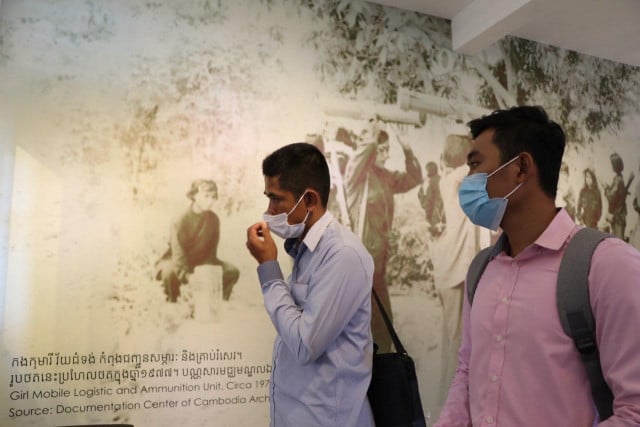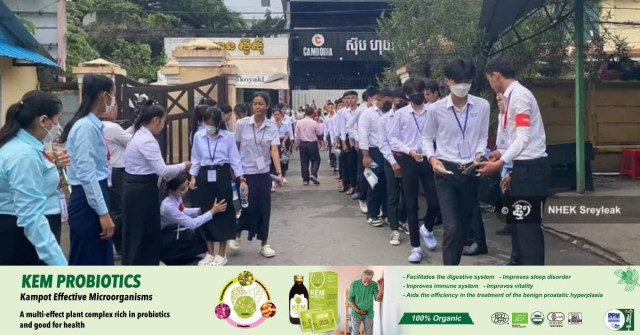DC-Cam Opens a Center in Takeo Province about the Khmer Rouge Regime and its Aftermaths

- Michelle Vachon
- July 29, 2020 2:30 AM
The center will help train history teachers who will cover that period in public schools and try to help those who lived through the regime share their stories with their children and grandchildren
PHNOM PENH--In the early 1970s, as Cambodia was in the midst of civil war, Takeo Province was already under Khmer Rouge rule.
The first of the work camps, which would be set up throughout the country during the regime, was open around 1973 in that province, along with a prison and killing center overseen by Ta Mok, who would be involved in numerous Khmer Rouge purges in the country and happened to be from Takeo Province.
So last year, when the Documentation Center of Cambodia (DC-Cam) decided to open a center in Takeo Province in cooperation with the Ministry of Education, plans incorporated the specific events that took place in that province during that period.
Its program will also reflect the legacy that Cambodia inherited following decades of war and conflict in the 1970s and 1980s, and with which many who lived through them have yet to come to term.
Teaching the teachers on how to address this period of recent history
The center was Inaugurated on July 27 in the presence of Lork Chumteav Ton Sa-Im, under-secretary of the Ministry of Education, Youth and Sport who made the opening remarks at the opening ceremony—due to the COVID-19 pandemic, the event only involved around 20 guests who wore facemasks, had their temperature taken upon arrival and respected social distancing.
Since one of DC-Cam’s roles is to help train those who teach this period in history classes in public schools, the center is located in the regional teacher-training center in Takeo province. “[W]e don’t want teachers to teach genocide the wrong way in Cambodia,” said Pheng Pong Rasy, director of the genocide research and education program at DC-Cam.
As he explained, there tends to be two groups of history teachers in the country’s public schools. The first one consists of teachers who lived during the regime (April 1975 through January 1979) or the civil war that followed in the 1980s. “They feel anger and they put this anger into their teaching, and the students feel that anger,” Rasy said.
“The other teachers are the young ones who were born after the Khmer Rouge regime,” he said. “They don’t know about the Khmer Rouge or how to teach that period. So that is why we want to bring in both groups of teachers to explain how to teach the genocide in Cambodia…to discuss the content of history and give them teaching methodology.”

Reflecting events still haunting people today
The Takeo Documentation Center was also designed to reflect the history of the province in the 1970s.
“If you visit the office, you will see 30 portraits of people who now are living in Along Veng,” Rasy said. Originally from Takeo Province, they are relatives of former Khmer Rouge members who moved to that district of Oddar Meanchey Province and never returned, he said.
There also are 36 portraits of former Khmer Rouge prisoners from Takeo province, Rasy said. “All these photos were taken at the Tuol Sleng [extermination camp in Phnom Penh] between 1976 and 1978. So this means that all the people in those portraits died during the Khmer Rouge regime.
“Both groups of people were from Takeo originally,” Rasy added.
These two series of portraits reflect the complex situation that the Khmer regime and the war that followed in the 1980s left behind and with which many continue to struggle.
“By 1973, about 80 percent of the territory of the country [including Takeo Province] was controlled by the Khmer Rouge,” said So Farina, DC-Cam principal deputy director. People were forced to join the ranks of the Khmer Rouge and, during the purges conducted by the regime in 1977-1978, many who had done so went to Along Veng, which became a Khmer Rouge stronghold in northern Cambodia, she said. And they never returned either because they were afraid of retaliation if they went back home, or because they had rebuilt their lives in Along Veng, she said.
Displaying these series of photos at the Takeo Documentation Center is part of DC-Cam’s effort to have them reconnect with their relatives in Takeo province. “[T]oday, only their photos appear in Takeo,” Rasy said. “But next time, they may come to Takeo themselves to see, to meet and talk to their families.”
Because reconciliation is a goal of DC-Cam’s regional centers: to enable interaction between victims of the regime who managed to survive and former Khmer Rouge, Farina said. And to encourage them to speak with their children and grandchildren to whom many survivors have never really told what they went through in the 1970s and 1980s, she said.

Reaching out to people across the country both online and in person
Due to the need to communicate online rather than in person during the pandemic, DC-Cam in Phnom Penh has set up space and equipment that enable people to hold online conferences in Phnom Penh that people can attend live in the Takeo center, Rasy said. In addition, the Takeo center provides people with access to DC-Cam’s online vast archives on the Khmer Rouge regime, he said.
But all cannot be accomplished online, which is why having an actual center is important, said Farina. “[P]hysical access is as important as online because, in order to remind Cambodian people and the world of the genocide and to prevent the recurrence of the violence here and there, we need to have physical existence and continued effort.
“So this is one of the main reasons we establish this center, and centers in various provinces,” Farina said. “Plus to emphasize that people or survivors are not only in the city but everywhere across the country and we need to get close to them.”
This is why DC-Cam plans to open several centers within the next two years, she added
The Takeo Documentation Center was open mainly through support from the United Nations Development Programme in Cambodia.
The USAID provides core support for the opening of DC-Cam centers throughout the country. The European Union has also contributed to one of the center projects.















